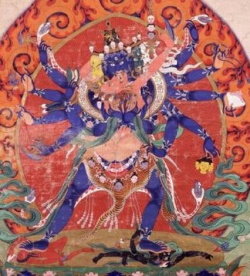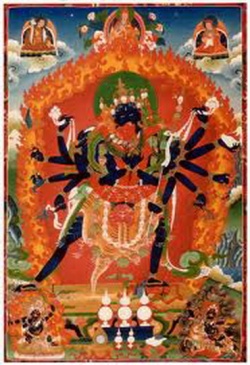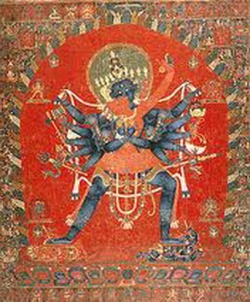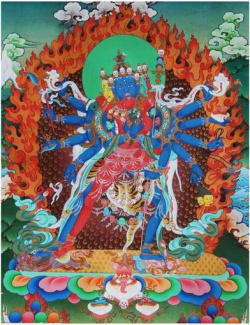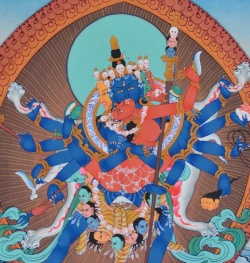Cakrasaṃvara
Click here to see other articles relating to word Cakrasaṃvara
Cakrasaṃvara is a Sanskrit term for a meditational deity particularly important to the Karma Kagyu tradition of Tibetan Buddhism as well as the other lineages in the sarma schools in Tibet. He is often depicted in consort with Vajrayogini. Chakrasamvara: One of the Ten Dharma Protectors
འཁོར་ལོ་སྡོམ་པབདེ་མཆོག། Chakrasamvara ('khor lo bde mchog). a wrathful deity who is usually depicted as blue in colour, with four faces and twelve arms, and in union with his consort Vajravarahi. Chakrasamvara is one of the main yidams of the Anuttarayoga Tantra of the Sarma schools, and especially of its mother tantras.
Chakrasamvara (Chinese: 胜乐金刚 shènglè jīngāng; Tibetan: Korlo Demchog, Wylie: khor lo sdom pa / bde mchog) - "is a heruka (and known simply as Heruka to Gelugpa Buddhists) and one of the principal Yidam, or meditational deities of the Sarma schools of Tibetan Buddhism. The Cakrasaṃvara sadhana is considered to be of the mother class of the Anuttara Yoga Tantra."
The Cakrasaṃvara Tantra, Chinese: 胜乐金刚 shènglè jīngāng; Tibetan: Korlo Demchog Gyud ; Wylie: khor lo sdom pa / bde mchog gi rgyud) is considered to be of the mother class of the Anuttara Yoga Tantra in the Indo-Tibetan Vajrayana Buddhist tradition.
The central deity of the mandala, a heruka known as Saṃvara (variants: Saṃvara & Saṃbara) or simply as Śrī Heruka,[1] is one of the principal ishtha-devatā, or meditational deities of the Sarma schools of Tibetan Buddhism.
Saṃvara is typically depicted with a blue-coloured Body, four faces, and twelve arms, and embracing his consort Vajravarahi (in Chinese 金刚亥母 jīngāng hàimǔ)in the Yab-Yum position. Other forms of the deity are also known, with varying numbers of limbs. Saṃvara and consort are not to be thought of as two different entities, as an ordinary husband and wife are two different people; in reality, their divine embrace is a metaphor for the union of great bliss and Emptiness, which are one and the same essence.
Samvara manifests in a number of forms, including a two-armed form. As one of the principal yidams of the Kagyupa lineage of Tibetan Tantric Buddhism, he is most often depicted in this form and in union with the red Wisdom Dakini Dorje Phagmo. In Western Meditation texts the name Cakrasamvara or Korlo Demchog is often translated to mean Highest Bliss. Meditation on Korlo Demchog is an advanced practice transmitted by ones Lama, and binds the mind of the meditator to Enlightenment itself.
The six yogas are a synthesis or collection of the Completion stage practices of several tantras. In the Kagyu traditions by which the six yogas were first brought to Tibet , abhiṣeka into at least one Anuttarayoga Tantra system (generally Cakrasaṃvara and/or Vajrayogini/Vajravarāhi) and practice of its utpatti-krama are the bases for practice of the six yogas; there is no particular Empowerment for the six yogas themselves.
As Nāropa is regarded as a Kagyu lineage holder, the six meditative practices are strongly associated with the Kagyu lineage of Tibetan Buddhism. The teachings of Tilopa(988-1069 CE) are the earliest known work on the six yogas. Tilopa is said to have received the teachings directly from Cakrasaṃvara. Nāropa learned the techniques from Tilopa. Nāropa's student Marpa taught the Tibetan Milarepa, renowned for his yogic skills. Milarepa in turn taught Gampopa. Gampopa's student, the future first Karmapa, Düsum Khyenpa, attained Enlightenment while practicing the six yogas.
Vajrayoginī and Vajravārāhī are interchangeable in that they are both considered to be the consort of the [[heruka [Cakrasaṃvara]]. The name Cakrasaṃvara may be translated as “wheel-sacrament”. In an earlier chapter we examined the wheel as a mushroom Symbol and therefore the interpretation of Cakrasaṃvara as “mushroom-sacrament” remains a distinct possibility. The Cakrasaṃvara tāntra describes the sexual union of Vajrayoginī and Cakrasaṃvara though, as with all tāntras, this is intended to be understood on many levels. The interpretations range from subtle yogas of bodily energies to teachings on the inseparability of voidness and bliss. Heruka and Vajrayoginī are considered to be fully equivalent to other such pairs such as Hevajra and Nairatmya in the Hevajra tāntra.
The widely propagated teaching and manuals of Meditation (sgrub yig) according to the initiation and Tantra of Śrī Saṃvara, originated first in the Spiritual Lineage of the disciples of the Great-Translator (rin chen bzang po). In later times mar pa do pa, spu hrangs lo chung, mal gyo and others taught extensively this Tantra.
The Lineage is as follows: Vajradhara, Vajrapāṇi, Saraha, sha ba ra dbang phyug and his disciple lu yi pa whom some call lu i pa and some lu hi pa. My teacher the great paṇḍita used to say: "There exists a book on the Sampannakrama degree composed by him, and in the Sanskrit text of the eighteenth śloka, (his name) is written as lu yi, so this (form) must be correct." lu yi pa taught the Tantra to king da ri ka pa and his minister ḍanṅgi pa. The latter taught it to rdo rje dril bu pa; the latter to ru sbal zhabs can; the latter to Jayandhara; the latter to Kṛṣṇācārya (nag po spyod pa ba); the latter to Vijayapāda (rnam rgyal zhabs); the latter to Tilli pa and he in turn taught it to na ro pa. The biographies of teachers who preceded the last named are numerous, and since it is easy to consult them, I did not write them down.
Na ro pa: he was the guardian of the northern gate of Vikramaśīla. The ācārya Śānti pa and the Venerable Maitrīpa heard the Tantra from him. The Venerable Master (Atīśa) heard it from Śānti pa. Atīśa in his turn taught it in mnga' ris to the Great Translator (rin chen bzang po) and his disciples. He also taught it to 'gar dge ba of gtsang rong. It is said that he expounded the text with the help of the commentary of Devarakṣita.
Further, the Master taught The Precepts (of this Tantra) in dbus to nag tsho lo tsa ba and to an aged khamspa. Further, a Nepālese known as pham mthing pa or a nges pa chen po had four brothers: the elder Dharmamati, and two {R 381}younger ones dus 'khor pa and thang churng pa. Dharmamati spent 12 years with na ro pa. pham mthing pa went to invite him. The elder said: "You, yourself stay here! Having received a prophecy from (my) teacher, I shall proceed to wu t'ai shan". He went away without anyone knowing where he was going.
Pham mthing pa attended on na ro pa for nine years and heard from him (the exposition) of many doctrines, including that of Saṃvara and the Hevajra. He obtained the lower and intermediate Siddhis with the help of the Cycle of Saṃvara. His younger brother dus 'khor ba attended on na ro pa for five years, and also heard many doctrines, such as the Saṃvara Cycle and others. The youngest thang khun pa came to invite dus 'khor ba, and also obtained initiation and some instructions in the Tantra from na ro pa. The elder brother said to thang ?chun pa: You should meditate on Vāgiśvara". He followed the advice and meditated. He threw a flower into a stream (in order to test his attainments) and three times the flower floated up-stream. The first two times they did not notice it, but on the last occasion when the flower floated upstream, he picked it up, and thus he did not obtain the higher and middle powers of Vāgiśvara, but he obtained the lesser powers by which he was able to compose ślokas and learn texts by Heart.
When the flower was carried downstream, a servant named Bhadanta drank of this water and obtained very great Wisdom. pham mthing pa then said to thang chung pa: "You go to Tibet and look for gold, here (meaning the residence of na ro pa) you should keep the {R 382} eternal lamp (burning)". thang chung pa then took with him Bhadanta as servant and proceeded as far as gnyal. The servant Bhadanta while looking after horses at ngur smrig, learnt Tibetan. From brang ti he heard (the exposition) of the Abhidharmasamuccaya and mastered it. When he discussed it with the ācārya, he won the debate. Bhadanta then said to brang ti: "When I shall come again here as paṇḍita, you, Teacher, should receive me!" They, the master and servant, collected 500 golden srangs, and eternal lamps and gaṇacakras were kept up without interruption (at Pulahari in the vicinity of Nālandā).
The lo tsa ba klog skya shes rab rtsegs heard the Tantras of the Saṃvara Cycle from pham mthing pa. When the latter came to Tibet, the mal gyo lo tsa ba blo gros grags obtained the Saṃvara initiation and method of Concentration from him. Later mal gyo himself went to Nepāl and thoroughly heard the Cycle of Saṃvara from pham mthing pa and (his) brother Bodhibhadra (byang chub bzang po), a disciple of na ro pa, and the Nepālese Mahākaruṇa, a disciple of the Nepālese Kanakaśrī. The bla ma sa chen (kun dga' snying po) heard it from him. When the latter was expounding the Tantra, sun lung pa bsod nams rdo rje wrote down notes, which became known as the "Commentary composed by sa chen". sa chen taught it to his own son rtse mo (rje btsun bsod nams rtse mo) and brother. This Venerable One taught it to Śa skya pang chen. dmar chos kyi rgyal po heard the Saṃvara Tantra from the Venerable One (bsod nams rtse mo). The pang chen taught him the three Tantras together with precepts.
This dmar chos kyi rgyal po belongs to the line of the nephew of [[dmar[chos kyi rgyal mtshan]], a disciple of spu hrangs lo chen. He had three nephews: dmarshes rab rdo rje, thub pa shes rab and brtson 'grus rdo rje. He studied under his own uncle brtson 'grus rdo rje the Saṃvara-Tantra, according to the teaching of the Lineage of his own teacher, the Yoga {R 383} Tantra, the "Six Doctrines" of lo tsa (lo tsa chos drug]] i.e. rin chen bzang po'i chos drug) and other texts. There must have existed many lineages of disciples, holders of the Doctrine of Saṃvara, originated from sa skya pa, father and sons, but I did not hear of anyone else, except dmar chos rgyal, and therefore I am unable to write about it.
Mar pa do pa was born in the family of yar 'brog bla do, in which many kalyāṇa-mitras had been born. His father was named kalyāṇa-mitra chos rgyal. His own name was chos kyi dbang phyug. At first he studied Sanskrit with a paṇḍita and met rong zom chos kyi bzang po. Later he studied also with go rub lo tsa ba tshul khrims rgyal ba. Then he proceeded to Nepāl and it is said that he met there mar pa lho brag pa who was returning from India.
According to this (story) and the account of his meeting with cog ro chos rgyal, this lo tsa ba seems to have been born, when the Venerable mar pa was about 31. He lived to the age of 95. He presented to mar pa lho brag pa one golden zho when he met mar pa. mar pa said to him: "You may be in need of even one golden se be. You take it yourself. I am going to Tibet to sweep gold. na ro pa is not there, as he has gone for Secret (Tantric) practice. You should listen to the Doctrine from the four disciples of na ro pa." Then when mar ?pa do pa arrived in ti ra hu ti, a large crowd had gathered, and he inquired: "What was there?" They said to him: "We are looking at the coming of na ro pa." He mingled with the crowd, and having approached na ro pa, offered him one golden zho. na ro pa after holding it in his hand, threw it on the ground and gazed at him with wide-open eyes. Though he did not say anything, mar pa do pa understood that he had been blessed (by na ro pa). After that (mar pa do pa) proceeded to Magadha.
Following the advice received from mar pa lho brag pa, he obtained the initiation into the Cycle of Saṃvara, the Tantra and its precepts according to the system of na ro pa, from na ro pa's {R 384} disciples Manakaśrī, Prajn͂͂ārakṣita, kha che byang chub bzang po and Pramudavajra. He also heard many instructions from many paṇḍitas.
After returning again to Nepāl, he heard the exposition of the na ro pa's system from pham mthing pa, from the latter's younger brother Vāgiśvara (ngag gi dbang ?phyug) and the Nepālese Kanakaśrī. He also received many instructions from the Siddha phyag na, a direct disciple of Maitrī pa, who was residing in Nepāl. He also studied under the brāhmaṇa Kṛṣṇapāda, a disciple of the Nepālese dza hūṃ. He translated many texts belonging to the Cycle of Saṃvara with the assistance of Sumatikīrti.
On reaching Tibet, this lo tsa ba (mar pa do pa) gathered numerous disciples who heard from him the Cycle of Saṃvara, and gtsang mi mkhas pa rgya nam, do'i gze ba blo ldan and cog ro chos rgyal of khams continued successfully his Spiritual Lineage. A disciple of the Lord sgam po pa, possessed of excellent Knowledge, and known as la yag pa byang chub dngos grub, also obtained from gze ba the Cycle of Saṃvara, according to the system of mar pa do pa (mar do) at bla do. He composed an extensive commentary, basing himself on the instructions received by him from sgam po pa, on the (Saṃvara) mūla-tantra and the kun spyod. He also composed a commentary on the commentary of the Pan͂͂cakrama by dril bu pa and an exposition of the Utpannakrama (bskyed rim). mar pa do pa himself composed an extensive commentary and a summary on both the Mūlatantra and the Yoginī-san͂͂caryā.
When the son of mar do, named na mkha' 'od was born, he obtained the complete precepts of his father's teachings. He went to skyi sod (lha sa) and other places. He taught to others short precepts died at one and the same time with his father, so {R 385} that his Lineage did not continue. gze ba taught (the system) extensively to his own son bde mchog rdo rje. From the latter the lineage received a great spread. mkhyen rab dbang phyug heard the exposition of the Cycle of Saṃvara from yan rtse ba rin chen seng ge. He also heard it from khang gsar pa bsod nams mgon, but he used to say that he had not found the preceding Lineage. It must have been the school of mar do (mar pa do pa).
Its Lineage of initiation: The Buddha (Cakrasaṃvara), Vajravārahī (ye shes , mkha' 'gro ma), lu yi pa, ḍeṅgi pa, la ba pa, Indra-Bodhi (Indrabhūti), ka tsa pa, Vajraghaṇṭa (dril bu pa), Jālandhara pa, Kṛṣṇācārya (nag po pa), ku sha la na, Tilli pa, na ro pa, Manakaśrījn͂͂ana, the Nepālese Bhadanta, mar pa do pa, gze ba blo ldan, gze ba jo bde, the ācārya khu lhas pa, the ācārya lho tshang pa, the lo tsa ba mchog ldan, the bla ma dpal ldan seng ge, and bu ston.
In general, bu ston rin po che was the holder of seven different Lineages of initiations into the Cycle of Saṃvara. bu ston rin po che (bu ?ston) composed an exposition of the system of lu yi pa, and its maṇḍala rite. He also composed a commentary called 'khrul spong on the Śrī-Cakrasaṃvara-sādhana-nāma and a commentary on both the bde mchog rtsa ba'i rgyud and the Yoginī-san͂͂caryā. {R 386} He also wrote on the maṇḍala rite of Saṃvara. From among the many manuals on maṇḍala rites composed (by bu ston), in this manual he discussed in details the fourth initiation. cog ro chos kyi rgyal mtshan, was born in the year Earth Male Mouse (sa pho byi ba - 1108 A.D.) in Lower khams. At the age of 19, he came to the school of rgya dmar (stod lung). This Earth Mouse year is the Mouse year which preceded the Iron Tiger year (lcags stag - 1110 A.D.) in which dpal phag mo gru pa was born. He studied the Pramāṇaviniścaya (tshad ma rnam nges) and the teachings of the school known as Mādhyamaka-Svātantrika (dbu ma rang rgyud), and became a learned man. At the age of 24, he taught the Pramāṇaviniścaya. His fellow students at the school were: the Lord phag mo gru pa, mkhan po ka ba and 'bal tshad ma pa. do pa's son jo sras nam mkha' also came to that school. cog ro also obtained from him the lesser precepts and studied extensively under ar and the khams pa a seng. At gzhung he studied with rngog mdo sde the Cycle of Hevajra and the Māyā, as well as composed a text-book called rin chen ljong shing. After that, on three occasions he visited the bla ma (mar pa) do pa, and pleased the Teacher with offerings. He studied the Saṃvara-Tantra together with its branches, and mastered it thoroughly. jo sras revealed to him the hidden precepts (possessed by his father).
The bla ma lo tsa ba (i.e. mar pa do pa) passed away at the age of 95. About the same time jo sras also passed away. After that, he (cog ro) studied the Vajravārahī Cycle with a direct disciple of ha mu dkar po called dpyal lo kun dga' rdo rje. Then he taught for a while the exposition of the (Pramāṇa)viniścaya, and meditated for six years at gnam ?tsho. After that he founded the me dge lha ?tsho, and established there a college (brad grwa) and a meditative {R 387} school (sgom grwa). (He) had hunters as disciples who proceeded to Heaven without leaving their physical bodies behind. He (cog ro) composed a commentary on the (bde mchog) rtsa rgyud and taught it extensively. He lived to the age of 69 and died on the second day of the month of Kārtika of the year Fire Ape (me spre 1176 A.D.). His method of explaining basic texts was continued by the kalyāṇa-mitra gu Śrī'brom pa , rong po dge rings and others. The great ācārya of 'bri khung (continued) to bestow initiations (according to his method). zhang maintained the abbot's chair. zhang was named tshul khrims shes rab. He, having met 'bri khun pa, attained the understanding of the Mahāmudrā (Buddhahood), His disciple was kun tu 'od. rom po ba was a disciple of these two. I Doubt that these facts were obtained from the scholar gyor ston, who based himself on a statement by the ācārya Dharmaketu.
kun tu 'od: (This) was his title (che ming), his real name being dbang phyug seng ge. He was also called rno ra ba. His disciple was zhang btsun smon lam dbang phyug, who lived till the age of 85, from the year Fire Ape (me spre 1176 A.D.) to the year Iron Ape (lcags spre 1260 A.D.). He was also a disciple of khro lo (khro phu lo tsa ba), and was a famous and great magician. His disciple was rdzong pa, who was born in the year Water Tiger (chu stag 1182 A.D.). At 20, in the year Iron Hen (lcags bya 1201 A.D.), he was appointed to the abbot's chair. He died at the age of 69 in the Iron Dog (lcags khyi 1250 A.D.).
His disciple known as the bla ma dam pa rin po che was born in the year Wood Female Sheep (shing mo lug 1235 A.D.). At the age of 16, in the year Iron Dog (lcags khyi 1250 A.D.) he was appointed to the chair. He died at the age of 39 in the year Water Hen (chu bya 1273 A.D.). He seems to have been called gnyan thog jo 'bum. The teaching of the {R 388} Saṃvara-Tantra has thus lasted for a long time. tre bo mgon po studied well the four ākhyā tantras (bshad pa'i rgyud) of the Samvara Cycle according to the method of mar do (mar pa do pa) with the great scholar rgya nam mkha'. idum ra sgang pa gnyan rdo rje seng ge heard (the Tantra) from him. He was pleased to bestow the teaching on snye mdo, the All-Knowing. The assistant translator of mar pa do pa grags pa shes rab studied in India and Nepāl under the teachers (at whose feet) mar do (mar pa do pa) had heard the Tantra. Later he studied extensively with the rājaputra Bhīmadeva. People used to say that the Junior Translator possessed more doctrines than the great lo tsa ba himself (i.e. mar pa do pa) and had numerous disciples. After having preached for a consider?able time the Cycle of Saṃvara, he practised Meditation at the cave of Śrī in Southern las stod. Soon after that he proceeded to Heaven.
I did not hear about the continuation of the exposition (of the Saṃvara Cycle by) his other disciples, except for the Lineage of dmar chos kyi rgyal mtshan, and for this reason am unable to give an account of it here. Further, the sum pa lo tsa ba of rong, Dharma yon tan proceeded to Nepāl, and requested a paṇḍita known by the name of Jayasena, who was also known as dam pa khang gsar pa and who later came to Tibet, and was attended on by the Venerable grags pa rgyal mtshan, to translate the Śrī-ḍakarṇava-mahāyoginītantrarāja its commentary composed by the Siddha Saroruha (mtsho skyes), as well as its initiation rite and sādhana composed by Jayasena. The deity Chakrasamvara is common to all the Sarma Schools of Sakya, Kagyu and Gelug. Within the latter he is commonly referred to as 'Heruka.' Among the many different forms and mandalas of practice this figure of Vajravarahi entwining the consort with both legs is common to the traditions of Mahasiddha Luipa and Maitripa.
{R 389} He revised the translation of the Tantra and its commen?tary at the request of his uncle dpal mchog dad pa'i rdo rye. This Tantra spread throughout Tibet from many quarters. The Dharmasvāmin rang byung rdo rje composed also many text-Books on it. Saroruha, the author of the commentary, seems to have been Padmavajra (pad? ma rdo rje) who belonged to this Lineage. Ratnarakṣita composed a commentary on the sdom pa 'byung ba. I am of the opinion that since chag lo tsa ba had been his direct disciple, he must have possessed the method of exposition of (this Tantra). In later times, the Venerable tsong kha pa also followed the Lineage of bu ston rin po che and wrote a commentary on the bde mchog rtsa rgyud, having compared the text with its ākhyā-tantra and the great commentaries on it; he also composed a mngon rtogs, a dkyil cho, a mngon dkyil (mngon rtogs dkyil 'khor), according to the system of Ghaṇṭa (dril bu pa), an Analysis of the Five Stages according to the system of Ghaṇṭa (dril bu rim lnga'i rnam par bshad pa) called rim lnga gsal don and the Practice of the great yoga of the Sampannakrama degree according to the method of lu yi pa" (lu yi pai lugs rdzogs pa'i rim pa rnal 'byor chen po nyams su len lugs) and the Exposition of the method of lu yi pa" (lu yi pa'i mngon rtogs kyi bshad pa) called 'dod 'jo. In this manner he revived the practice of the Cakrasaṃvara ('khor lo sdom pa) which had deteriorated (in Tibet).
Chakrasamvara Lineage, Abisheka, Root Tantra and Commentary: Vajradhara, Vajrapani, Maha Brahmin Saraha, Acharya Nagarjuna, The Protector Shavari, Luipa, Darikapa, Vajra Ghantapa, Kumarapada, Jalandharapa, Krishnacharya, Guhyapa, Nampar Gyalwai Shap, The Acharya Barmai Lobpon, Tilopa, Naropa, Pamtingpa Kuche Nyi, Lama Lokkya Sherab Tseg, Lama Mal Lotsawa, The Lord of Dharma Sakyapa (Sachen Kunga Nyingpo 1092-1158).
The principal tantra of the Anuttarayoga Wisdom (mother) classification of the Vajrayana Buddhist Tradition. Chakrasamvara is one of the most popular deities in Tantric Buddhism in the Himalayan regions and Tibet after the 11th century. He can appear in several dozen different forms, from simple to complex and peaceful to wrathful, which makes it necessary to rely on the descriptive literature in the Sanskrit and Tibetan languages to identify him. Adding to the complexity, there are more than fifty different traditions of these forms in Tibetan Buddhism. They are meant to emphasize different types of Meditation practice that are suited for specific types of emotional and psychological characteristics in the tantric practitioners who take on these intricate practices.
